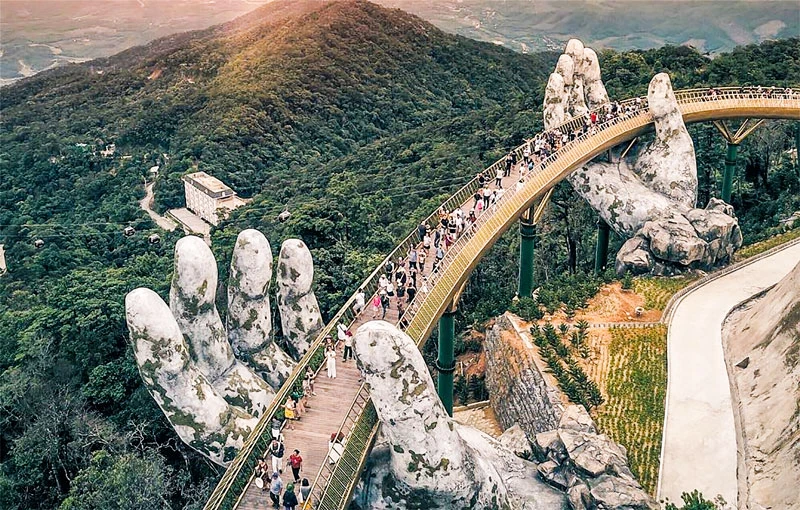
However, this has led to conflict of interest among those who oppose tourism development projects that could possibly harm the eco-landscape.
More investment required
According to the General Department of Tourism, in 2018, the tourism sector reached a target of 15.5 million international arrivals, and served more than 80 million domestic tourists, with total revenue from tourism alone reaching upto VND 620,000 bn. In particular, major tourist centers across the country even showed a higher growth rate. Ho Chi Minh City welcomed 36.5 million tourists (7.5 million being international tourists), Hanoi welcomed about 28 million tourists (5.5 million of which were international tourists), Quang Ninh welcomed 12.5 million tourists (5.3 million being international tourists), and Da Nang welcomed 7.7 million tourists (with 3 million international tourists).
In 2019, the tourism sector set a goal to welcome 103 million tourists, including 18 million international tourists and 85 million domestic tourists. The tourism sector is determined to reach their destination one year ahead of their target as per Resolution 08 of the Politburo on Tourism Development, welcoming 17-20 million international tourists, and serving 82 million domestic tourists. In the first nine months of 2019, Vietnam welcomed 12.78 million international tourists, an increase of 10.8% over the same period and over 66 million domestic tourists, contributing 7.8% to the GDP.
According to a recent ranking by the World Tourism Organization, Vietnam's natural resources ranked 34/140 in the world, and cultural resources ranked at 29. These are all very high rankings and have improved much since previous years. In many localities, businesses have built high-end hotels and resorts and are all doing extremely well, while tour operators are also providing world-class services. In general, all segments in the tourism trade on the whole are now operating successfully.
With Vietnam offering great scenic beauty, and an indigenous exotic culture, there seems no reason for tourism not to grow even further and become the country’s key economic sector. However, it still lags behind neighboring Thailand, with Vietnam only drawing half the number of tourists in comparison, in both domestic and international tourism. What is the reason for this situation?
Commenting on this issue, Tran Dinh Thien, former Director of Vietnam Economic Institute, expressed concern that the tourism sector is racing for achievements as the number of tourists next year will be increasing much more compared to the previous years. However, investment in tourism is still not sufficient, or unique, or even of high standards. “Tourism resources at Ha Long, Da Nang, Da Lat and Phu Quoc need to have more investment support, if tourists are expected to stay longer and spend more”, emphasized Mr. Thien.
Trade-off seems unavoidable
Currently, some big real estate businesses such as Vingroup, Sungroup, FLC, and Tuan Chau have merged the development of real estate with tourism as one of their key segments. The construction of combined tourist resorts by these business companies will not only contribute to increasing the number of arrivals, and provide more beds, restaurants and shopping, but also change the whole life of areas such as Sam Son, Quy Nhon, Phu Quoc, and Ha Long. For example, in Da Nang, a series of Ba Na tourism development projects of large corporations such as SunGroup have helped this place become a popular tourist destination for both domestic and international tourists.
In a discussion with Saigon Investment, Mr. Thien pointed out, “to develop a sector or an area, you must accept a trade-off, and must balance benefits. One should decide how much trade-off is reasonable, prioritize your overall benefits and long term needs, keeping in mind the high standards required and the laws to be followed. If these are not clear, then no business nor the government will dare to do it”.
In this regard, the Ministry of Natural Resources and Environment has conducted studies on quantitative values of the environment, forests and other natural resources. For example, if a business wants to invest in a forest and requires to cut down the existing trees to build resorts, that business must plant more trees to replace the number that they fell. Besides, if the development must accept trade-offs, this should be based on clear scientific data and valid reasons.
Among the countries in the region, Singapore attracts about 19 million international tourists each year, nearly double of that visiting Vietnam. The country is expected to increase by an area of 100 sq. km for tourism by 2030, by slicing mountains and filling the sea. Vietnam possesses a vast coastline of more than 3,000 km and hundreds of islands suitable for economic development of tourism.
Therefore, tourism development projects require management agencies to assess the project and decide if they are appropriate and if they should be supported and executed. In addition, local governments need to be much more transparent about tourism as it affects the people, the natural environment, and the local culture. People must be more involved in discussions and debates, that allow both criticism and consensus, and thereby reduce any conflict among the public.




















